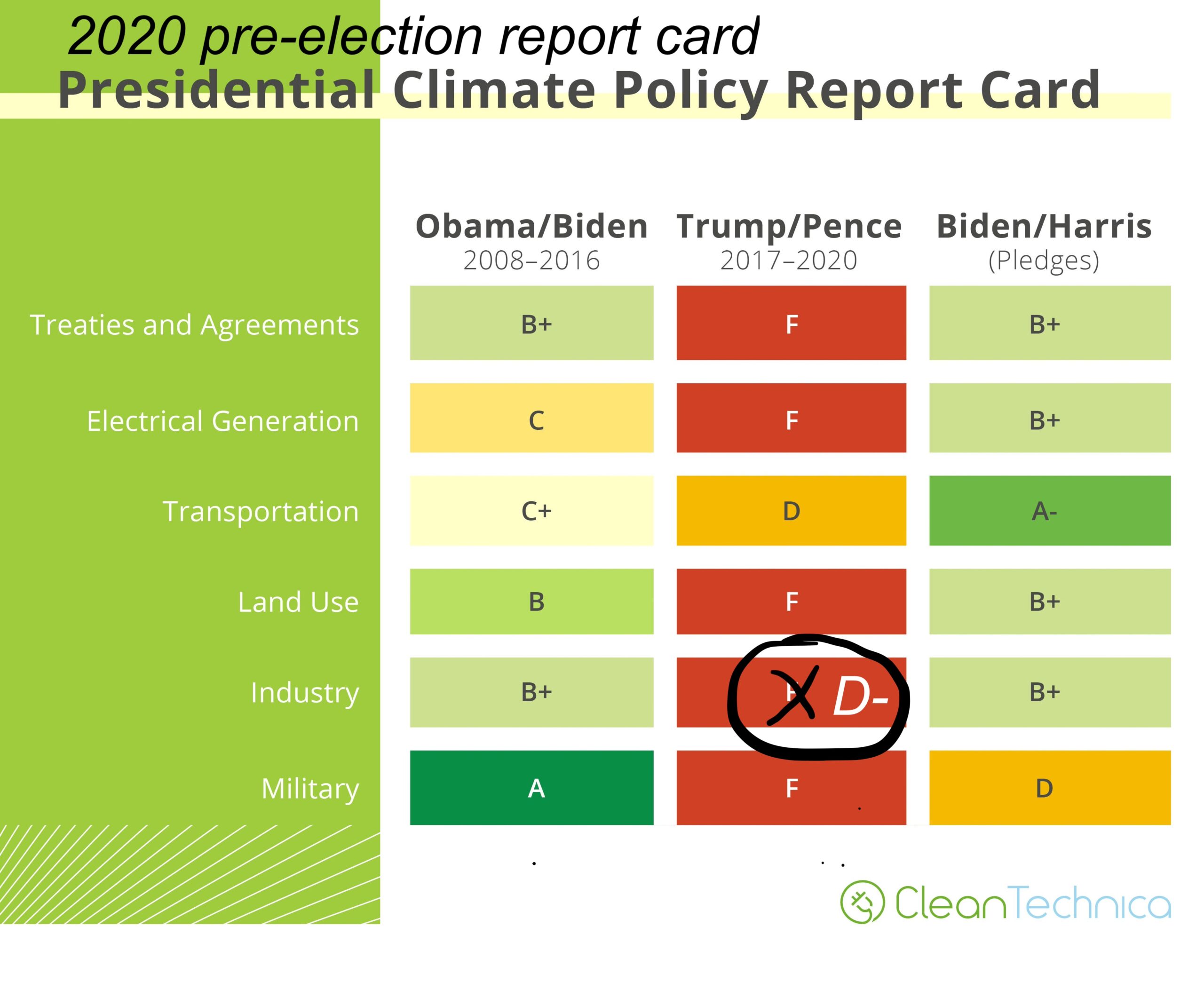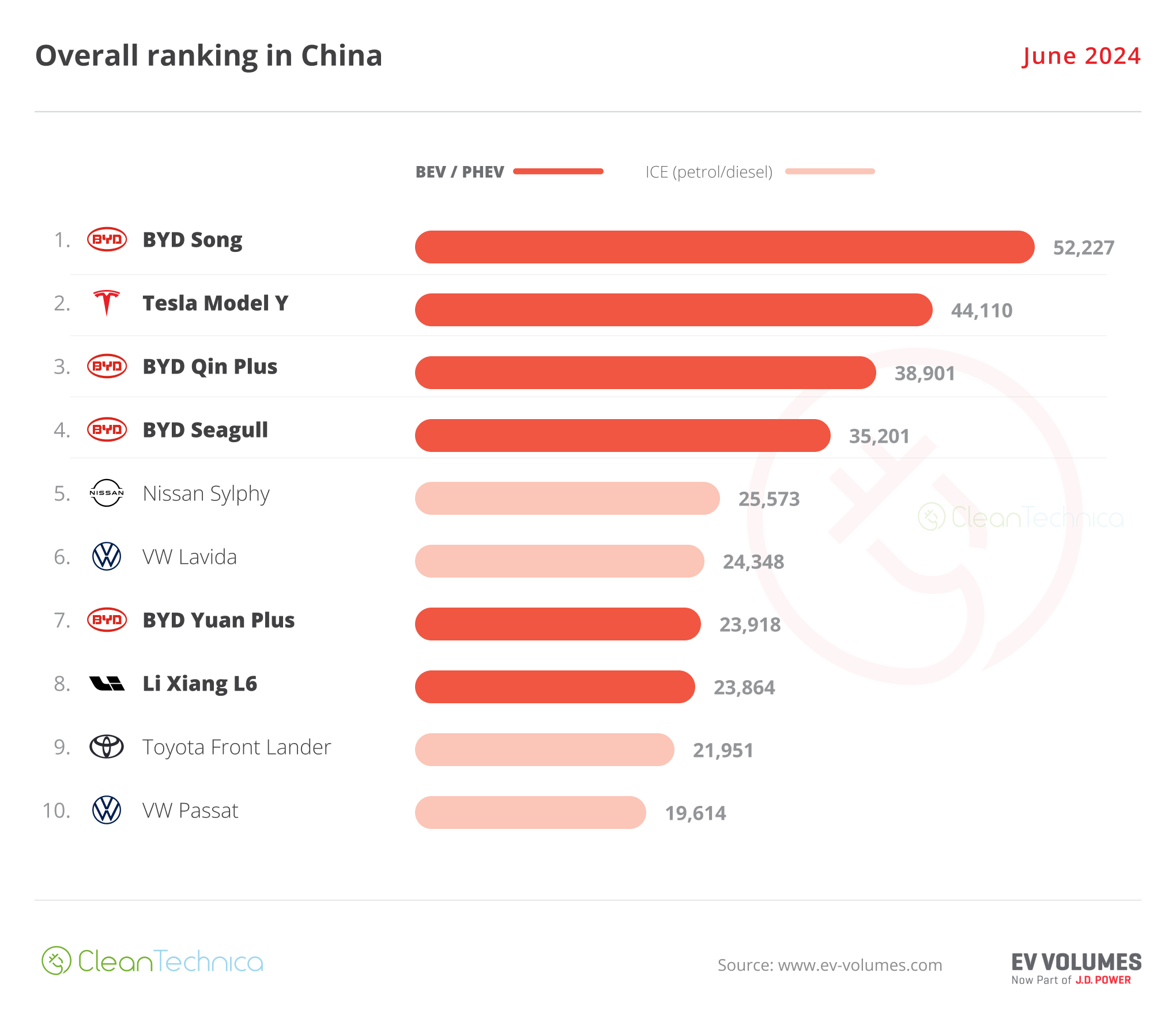Sign up for daily news updates from CleanTechnica on email. Or follow us on Google News!
Four years ago, as the United States election cycle once again brought the presidency into contest in addition to the Senate and the House, CleanTechnica published a Presidential Climate Policy Report Card. It’s time again to contrast administrations.
At the time, Trump’s and Pence’s climate legacy in office was clear, but the Biden/Harris ticket was only campaign promises. As a result, we cast our eyes back to the Obama/Biden Administration prior to Trump to contrast with both the intervening four years and the Democratic platform.

Obama and Biden had done some things well, but only scored an A on drawing down the military personnel based in foreign countries. While that left a legacy of extra-judicial drone assassinations in at least six countries, it was a positive from a climate perspective, as the military’s heavy fossil fuel consumption declined substantially. On treaties and agreements and on industry, Obama and Biden achieved a B+ based on my climate-oriented assessment. Land use only managed a B, transportation was only a C+, and electrical generation was a weak C.
This, of course, made them vastly better from a climate perspective than Trump and Pence, who only managed one rating that wasn’t a hard F, on transportation where they eked out a D due to heavy lobbying from the aviation industry to align with international ICAO policies, as deeply weak as those were.
For this assessment, we no longer have to cast our eyes back to 2008–2016, but can assess the Biden/Harris Administration’s track record. Trump’s term assessment mostly stands, but for each of the major categories, we’ll look at Trump’s campaign promises, for what that is worth. But that said, the needle on appropriately urgent climate action has changed, as have the global conditions. An update in 2024 has a higher bar with far more opportunities for acceleration than in 2020. As a consequence, grading is stricter.
The exception to the Trump/Pence report scores is on industry. In the fading days of December 2020, the administration passed the bipartisan American Innovation and Manufacturing Act. It contained declining annual allowances for different HFC refrigerants, despite the Trump administration staying out of the Kigali Amendment that dealt with those high global warming potential gases. It also established a market mechanism for HFC credit trading. This went unnoticed by most as the bill was passed on December 27, 2020, during the year-end holiday season, and January 6th’s attempted insurrection and follow-on attempts to dispute the election results by numerous Republican politicians, not least Trump himself, dominated news cycles and everyone’s attention.
However, with this bill, the USA enforced its first federal greenhouse gas pricing mechanism, in fact put a market mechanism in for HFCs before Europe, which will only include them in its emissions trading system and carbon border adjustment mechanism in 2026. Management and enforcement was assigned to the Environmental Protection Agency (EPA) in the bill, and the EPA had been severely weakened by Trump in his administration, so it was far from an unalloyed success. Regardless, the hard F that Trump and Pence received on climate action for industry in the middle of the year in the run-up to the election must be updated to a D-.
While not perfect, the Biden/Harris administration has delivered enormous movement on climate action, while Trump’s first term and promises are a sea of red, a tsunami of climate action failure. To be clear, that was true of most files under Trump from any objective perspective, whether it was the economy, response to the global pandemic, international relations, or human rights.
That the USA is once again considering the president ranked dead last on the recent YouGov, University of Houston, and Boise State University Presidential Greatness Survey, a man whose COVID-19 policies led to roughly 188,000 unnecessary deaths, a full 40% above what rational policies would have resulted in, a man who was impeached for incitement of insurrection as well as another impeachment for abuse of power and obstruction of Congress, a man who almost every world leader considers likely to create greater global conflict, a man who openly admires Russia’s Putin and is against any support for Ukraine, a man who openly wants to be a dictator, and a man convicted of 34 counts of falsifying business records related to the hush-money he paid to the porn star he slept with just after his wife had given birth is a matter of deep perplexity and concern for most people outside of the USA. That the Republicans have been so cowed by him and the MAGA movement after their six decades of U-turns on their great legacy for short-term gain is a deep concern for the country and the world. That he is neck-and-neck in polling with Biden is an extraordinary indictment of the country’s educational system and civic institutions.
That Trump is unfit to be president on any file is not the subject of this assessment however, but solely his policies that are applicable to climate change. He was unfit in 2016 as well and proved it over and over again during his four years in office. Yet here we are again.
We will use the same framework again.
As with all assessments, we must have a framework for consideration. Global warming has several large areas of causation. Electrical generation, transportation, land use, and industry all have greenhouse gas emissions. The US military, which is larger than the next seven [now ten] largest military forces in the world combined, is estimated to be one of the single largest greenhouse gas sources in the world and has not been required to quantify its emissions, but has been pointing out the significant global security risks of climate change for over a decade.
While dealing with the causes is critical, dealing with adaptation to the impacts is now important as well due to our delays in addressing this problem, which has been clear since the 1970s. While accelerating drawdown of carbon from the atmosphere is of lower priority than stopping emitting greenhouse gases, any plan should address aspects of drawdown as well. These aspects of any plan need to be assessed to see if they are addressed at all and if the approaches are reasonable. And, of course, there is the matter of the global ties that bind the world together, treaties and trade agreements and their implications for climate change.
For each of these categories, we’ll assess the four years of the Biden/Harris Administration, the good and the bad, then contrast them to the Trump administration and to Trump’s 2024 campaign promises. The Biden/Harris Administration’s efforts and track record stand by themselves, and campaign pledges are mostly to stay the course, and as such will only be mentioned in passing where pertinent.
And so, CleanTechnica‘s climate policy report card series for the 2024 election begins. Stay tuned for pieces on each of treaties and agreements, electrical generation, transportation, land use and industry, along with a wrap-up article summarizing it all over the next several days.
Have a tip for CleanTechnica? Want to advertise? Want to suggest a guest for our CleanTech Talk podcast? Contact us here.
Latest CleanTechnica.TV Videos
CleanTechnica uses affiliate links. See our policy here.





